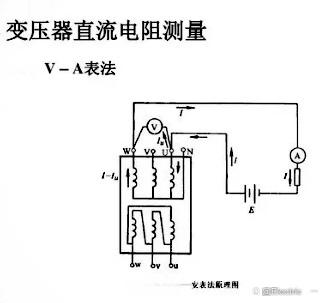-
Mail us
contact@tiger-transformer.com -
Phone us
(+86)15655168738
Mail us
contact@tiger-transformer.comPhone us
(+86)15655168738The DC resistance of the transformer refers to the DC resistance value of each phase winding. The purpose of measuring the DC resistance of the transformer is to check the welding quality of the winding joints and whether there is a short circuit between the winding turns; to check whether the contact of the tap changer is good and whether the actual position of the tap is correct. After the transformer is overhauled or the tap position is changed, or the outlet fault is short-circuited, the DC resistance of the winding and bushing needs to be measured.

1. Measurement method of DC resistance.
The measurement methods of transformer DC resistance include current-voltmeter method, DC bridge method, and constant current source bridge method.
1. Current-voltmeter method.
1) The current-voltmeter method is also called the voltage drop method. The principle is to pass a DC current through the resistance being measured and measure the voltage drop across the resistance. According to Ohm's law, in the same circuit, the current in the conductor is directly proportional to the voltage at both ends of the conductor and inversely proportional to the resistance of the conductor, that is The measured resistance value can be calculated.
2) When using the voltage drop method to measure DC resistance, the ammeter should be selected with a small internal resistance, and the voltmeter should be selected with a large internal resistance; the accuracy level of the measuring meter should not be lower than 0.5 class.
2. DC bridge method.
1) The DC bridge method is a method that applies the DC bridge balance principle to measure DC resistance. Commonly used DC bridges include single-arm bridges, double-arm bridges, and DC digital bridges.
2) When measuring DC resistance, the selection of the instrument should consider the size of the test current, the measurement range of the measuring instrument, and the nature of the test object to improve the accuracy and stability of the measurement. When measuring DC resistance, the equipment under test should be in a cold state, and there should be no significant difference between the temperature of the test object and the surrounding air temperature.
3) Due to the large inductance of the transformer, when measuring DC resistance, the self-induced electromotive force of the power supply is very high at the moment it is turned on and off. The DC resistance should be measured after the transformer is powered off, the high-voltage lead is removed and fully discharged. Take measurements. When measuring the DC resistance of a large high-voltage transformer winding, other windings of each voltage level other than those being tested should be short-circuited to ground to prevent high voltage from being generated when the DC power supply is turned on or off, endangering equipment and personal safety.
4) For large-capacity power transformers, because the charging time constant of the series circuit is very large, each measurement requires a long time to wait for the current and voltmeter indications to stabilize, so the working efficiency is very low, so it is often used Special instruments such as constant current power supply can be used instead of the power supply, which can greatly shorten the test time.
5) When the three-phase transformer does not have a neutral point lead-out line, the resistance between the lines can be measured and then the resistance of each phase can be calculated.
2. Test standards for transformer DC resistance.
1. For transformers above 1600kVA, the difference between DC resistances of each phase winding should not be greater than 2% of the three-phase average. For windings without neutral points, the difference between lines should not be greater than the three-phase average. 1% of the value.
2. For transformers of 1600kVA and below, the difference between the DC resistances of each phase winding is generally not greater than 4% of the three-phase average. For windings without a neutral point, the difference between the lines is generally not greater than that of the three phases. 2% of the average.
3. Compared with the previously measured value at the same location (converted to the same temperature), the change should not be greater than 2%.